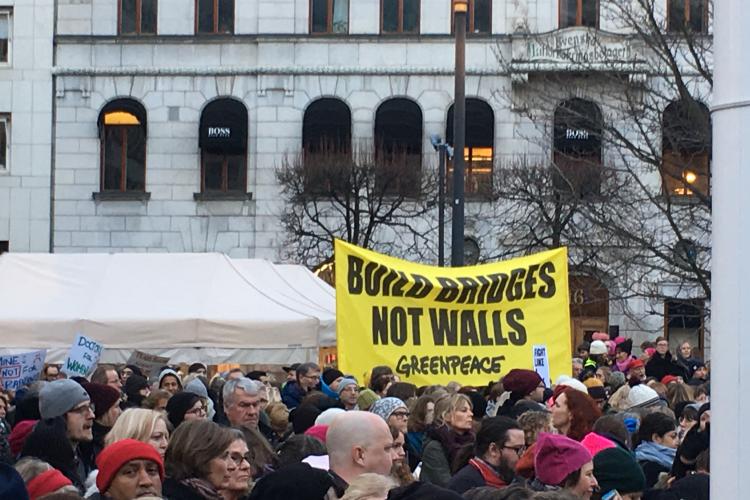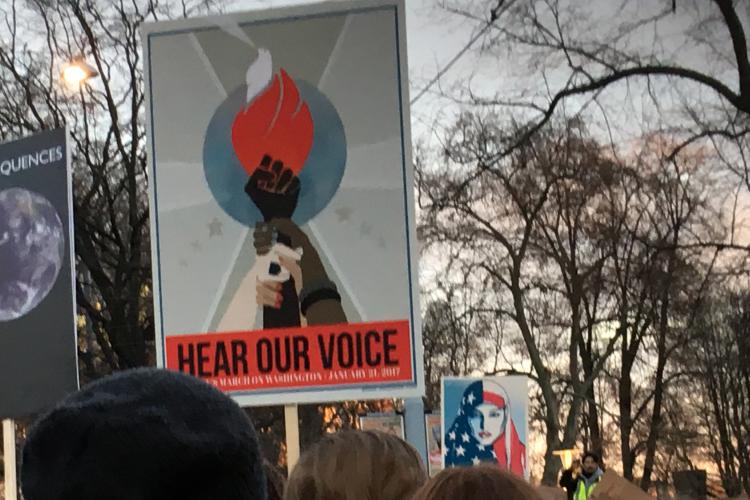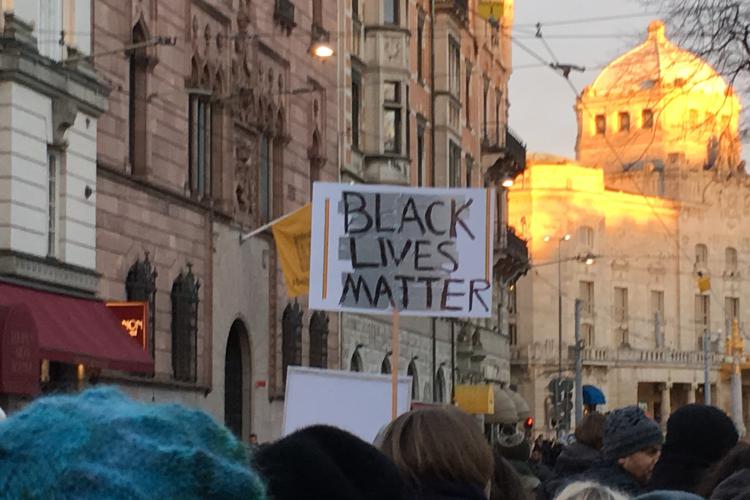Post by Vanessa Barker, Associate Professor of Sociology at Stockholm University and Associate Director at Border Criminologies. She is currently working on a new monograph about the border closing in Sweden called ‘Nordic Nationalism and Penal Order’. Recent publications include pieces on penal nationalism, the Stockholm Riots and the policing of ethnicity, REVA and deportation, Roma camp evictions, and the need for civic repair and penal reform in the US. This is the third post of our series on responding to the current political climate.
On January 21, 2017 over two million people poured out into streets around the world to stand up for women, social justice, and human decency. What started as a Women’s March on Washington turned into a truly global protest and emergent social movement with over 600 sister marches across cities and towns. Two million people stood together to oppose the ascendancy of an enfant terrible to the White House, a person who greeted the previous and auspicious day with a clenched fist rather than an open heart. The 45th President of the United States is a person who stands for retrograde beliefs about America and American values. It is a person who openly boasted about sexual assault on women, stoked violence against opponents, fantasizes about a ‘real’ America that is primarily, if not exclusively, white and isolated, and presents a dystopian vision of America that resembles the deserts and violence of Mad Max rather than present day America. In riposte to this uncertain future, a young girl, hoisted on the shoulders of a caregiver, held a cardboard sign that read: ‘Make America Kind Again.’

The homemade signs captured the spirit and energy of the crowds: ‘Pussies bite back’; ‘A Women’s Place is in the Resistance’; ‘I’m with Her’; others followed suit: ‘Viva the Vulva’; ‘Orange is the new Fascism’; ‘Nasty Woman’; ‘Injustice Anywhere is a Threat to Justice Everywhere;’ ‘Women’s Rights are Human Rights’; ‘We, the People’; ‘Build Bridges Not Walls’; ‘Black Lives Matter’; ‘Hear Our Voice’; ‘The Future is Female’; ‘We Stand as One’; ‘Our Bodies, Our Minds, Our Power’; ‘Hate is Not Great’; ‘So Bad, even Introverts are Here’; ’Fight like a Girl’; and from Antarctica: ‘Penguins for Peace,’ among thousands of other signs and posters that spoke to anger, outrage, power, brightness, possibility, resistance, and justice. They spoke of the rights of all women, migrant, Black, Native, Latina, immigrant, poor, disabled, white, lesbian, queer, and trans women to live free and live free from violence and discrimination . They spoke of solidarity and taking a stand together. As feminist icon, Gloria Steinem, beaming at 82 years old, said in Washington, if Muslims are forced to register: ’We will all resister as Muslims.’ Scrolling through the photo images of the protests on social media is surely to provide visual if not emotional relief to those of us who dreaded the day. The images are filled with women’s faces, all drenched in shades of pink, the color of optimism and compassion.

As an American living abroad, when the election results came in, I felt both a sense of relief to be in Sweden but also a sense of urgency to return to the US to fight for my beliefs and fight for my country. On Saturday, I was unable to travel to Washington DC so I was thrilled to be able to join a sister Women’s March in Stockholm. Here over 4000 people rallied in Norrmalmstorg to hear speakers from a broad coalition stand up for women’s rights on a global scale. Organizers and activists from Amnesty International, spokesperson for the Feminist Initiative political party Victoria Kawesa, Liberal Party’s MP Birgitta Ohlsson, feminists of color, Greenpeace, the Swedish Federation for Lesbian, Gay, Bisexual, Transgender and Queer Rights (RFSL), shout outs to Planned Parenthood International, among others, all relayed their sense of outrage and dismay at the state of US politics and its implications for women’s equality and rights. They each in turn insisted that women’s rights are human rights and that human rights are women’s rights, speaking up for reproductive rights across the global, urging the crowd to say ‘No to Racism’, to protect the environment and workers’ rights, and to stand up for the rights of lesbians, bisexuals, transgender, and queer rights, signified by the arrowed posters that read: ‘I’m with hen,’ the Swedish word that recognizes the full spectrum of gendered affiliations (an innovation that could easily be incorporated into the English language).
And like Women’s March on Washington, this Women’s March in Stockholm stood up for the rights of migrants and refugees, understood to be embedded in women’s and human rights. In Sweden, the rights of migrants and refugees are under threat due to the dramatic border closing last year between Sweden and Denmark, a closing that has reduced the inflow of asylum seekers and increased restrictions on mobility. In response to these infringements and in response to the proposed wall along the US-Mexico border, one of the biggest signs at the Stockholm rally read: ‘Build Bridges Not Walls,’ a message amplified by the speakers, protestors, and a message carried across the continents to repudiate the barbed wire and blockades marring the European Union, Britain, the United States, and Australia. It is a message of connection and vision for social justice. After the rally, we walked on to the US Embassy but were met with a concrete barrier that blocked access to the embassy for security reasons. Undeterred, spontaneously, the voices of young people took off and started a Swedish call and response: ‘Vad ska vi göra? Stoppa rasismen!’ ‘När?’ – ‘Nu!’; What are we going to do? Stop racism! When? Now!
Asked why they were marching, participants at every rally offered a full range of motivations. In Stockholm, one attendee captured a common sentiment: ‘Today it’s extremely important to stand up for the rights of women and minorities…I think we’ve already seen proof that a new world order is coming’ (Sandström quoted in Dagens Nyheter). Or as my friend and colleague at Stockholm University, Marie Evertsson explained, she was marching to protest the ‘uninformed narcissist’ who ‘represents a masculinity that I was hoping is in decay.’ As a sociologist who writes and teaches on gender and power, she is alarmed by changes in Sweden: ‘We are now seeing similar racist and misogynistic tendencies developing in Sweden and I find it extremely important that we do not sit by silently and observe. We must protest and take action. We need to put a stop to the hatred and work for a more loving, open and accepting world.’

The Women’s March on Washington and its global reach stand out as one of the largest marches for women’s rights in history. This emergent mass movement has the potential to make a historical impact on the fight for equality and social justice. It is a fight that includes the rights to mobility as central to its mission. Yet, its true potential and power depends on what happens next as the organizers, protestors and activists have stated. Participants are asking how to channel this spectacular event and fellow feeling into concrete political demands, proposals, policies, and outcomes? Many have explicitly said they want to avoid the fate of the Occupy movement, which stood at the precipice of transformative economic change without crossing it. Some participants have said they would now run for office. They must. Others are asking if it is possible for such a divergent coalition to stay together without collapsing in on itself? It must. The majority did not vote for this president. And this ‘American carnage’ must be made right.
Any comments about this post? Get in touch with us! Send us an email, or post a comment here or on Facebook. You can also tweet us.
__________
How to cite this blog post (Harvard style)
Barker, V. (2017) Women’s Global March on Washington, Reporting from Stockholm. Available at: https://www.law.ox.ac.uk/research-subject-groups/centre-criminology/centreborder-criminologies/blog/2017/01/women's-global (Accessed [date]).
Share:








